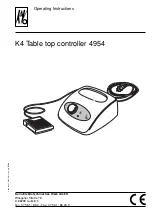
MEDIA RECLAIMER / SEPARATOR
Page 11
© 2005 CLEMCO INDUSTRIES CORP.
•
www.clemcoindustries.com
•
Manual No. 23438
•
Rev. E
mark along the reclaimer top (not the top liner) to ensure
the new baffle will be correctly aligned. When replacing
the baffle, align the baffle mounting holes, the side liner,
the top liner, and the top. When aligned, mark each part,
and tack the baffle to the inner tube.
7.2.5
Inspect all the liners. Replace any that have
worn through the rubber.
7.2.6
Side and inlet-side liners are held in place by
self-drilling screws. From the outside of the reclaimer,
remove the screws, and remove the liners.
7.2.7
The sump liner is glued to the cone with contact
cement. Peel the old liner out and remove all residue
from the cone.
7.2.8
Place the sump liner in the cone with the fabric
side down, and check the fit. Apply medium-set contact
cement, and install the sump liner.
7.2.9
Clamp the side liner in place, ensuring it is flush
with the top of the reclaimer body and aligned with the
inlet. Mark the side liner at the three bolt-hole locations
for the inlet baffle. Remove the liner and drill the bolt
holes. Reinstall the side liner. Align the three bolt-holes
and temporarily place bolts through the holes to hold it in
place. Clamp the liner, and while pushing the liner
against the weldment, secure it with self-drilling screws,
through each screw hole in the weldment.
7.2.10
Align the inlet-side liner and clamp it in place.
Use self-drilling screw at each hole location in the
weldment, to install the inlet liner.
7.2.11
Use silicone caulking to seal the seams all
around the inlet-side liner and reclaimer weldment,
between the inlet liner and side liner, and between the
side liner and sump liner. Wipe the caulking smooth.
CAUTION
All seams between each liner must be sealed,
and all seams between the liners and reclaimer
weldment must be sealed. Voids will cause
premature wear.
7.2.11
After the inlet baffle is aligned, and tacked to the
inner tube (See Section 7.2.3), align the top liner and
top, and apply caulking to the seam around the baffle
and top liner.
7.2.12
Apply caulking around the top edge of the side
liner and inlet liner, and install the top assembly. Secure
the top bolts and inlet baffle bolts.
7.2.13
Working through the reclaimer inlet, wipe the
caulking seal smooth. Apply additional caulking to
seams between the baffle and side liner. Re-caulk any
voids.
7.2.14
Install flex hoses.
7.2.15
Allow time for the caulking and sump liner
cement to cure before putting the reclaimer in service.
8.0 TROUBLESHOOTING
8.1
Excessive Media Carryover
8.1.1
Dust collector damper open too far. Adjust static
pressure per Section 5.1.
8.1.2
Vortex cylinder out of adjustment. Adjust vortex
cylinder per Section 5.2 or 5.3, depending on the
cylinder style.
8.1.3
Reclaimer door open or leaking. Check
reclaimer door and gasket for leaks. Air entering the
reclaimer at this point will cause media to be carried into
the dust collector. DO NOT operate unless all doors are
closed.
8.1.4
Leak in reclaimer weldment. Check entire
reclaimer for leaks.
8.1.5
Media level too high. Do not fill past cone. Load
media only through fill door.
8.1.6
Media level too low, causing air to be drawn in
through metering valves. Check level and fill if low.
8.1.7
If using very fine media (200 mesh and finer),
the inlet baffle of the reclaimer may need to be removed.
Consult the factory before proceeding with this option.
8.1.8
Reclaimer debris screen clogged with debris.
Check screen basket daily.
8.2
Reclaimer Not Recovering Media
8.2.1
Exhauster motor rotating backwards. The motor
should rotate as indicated by the arrow on the exhauster
housing. If it does not rotate in the proper direction,
LOCK OUT AND TAG OUT ELECTRICAL POWER and
switch the motor leads as shown on the motor plate.
Refer to the system’s wiring schematic.



































